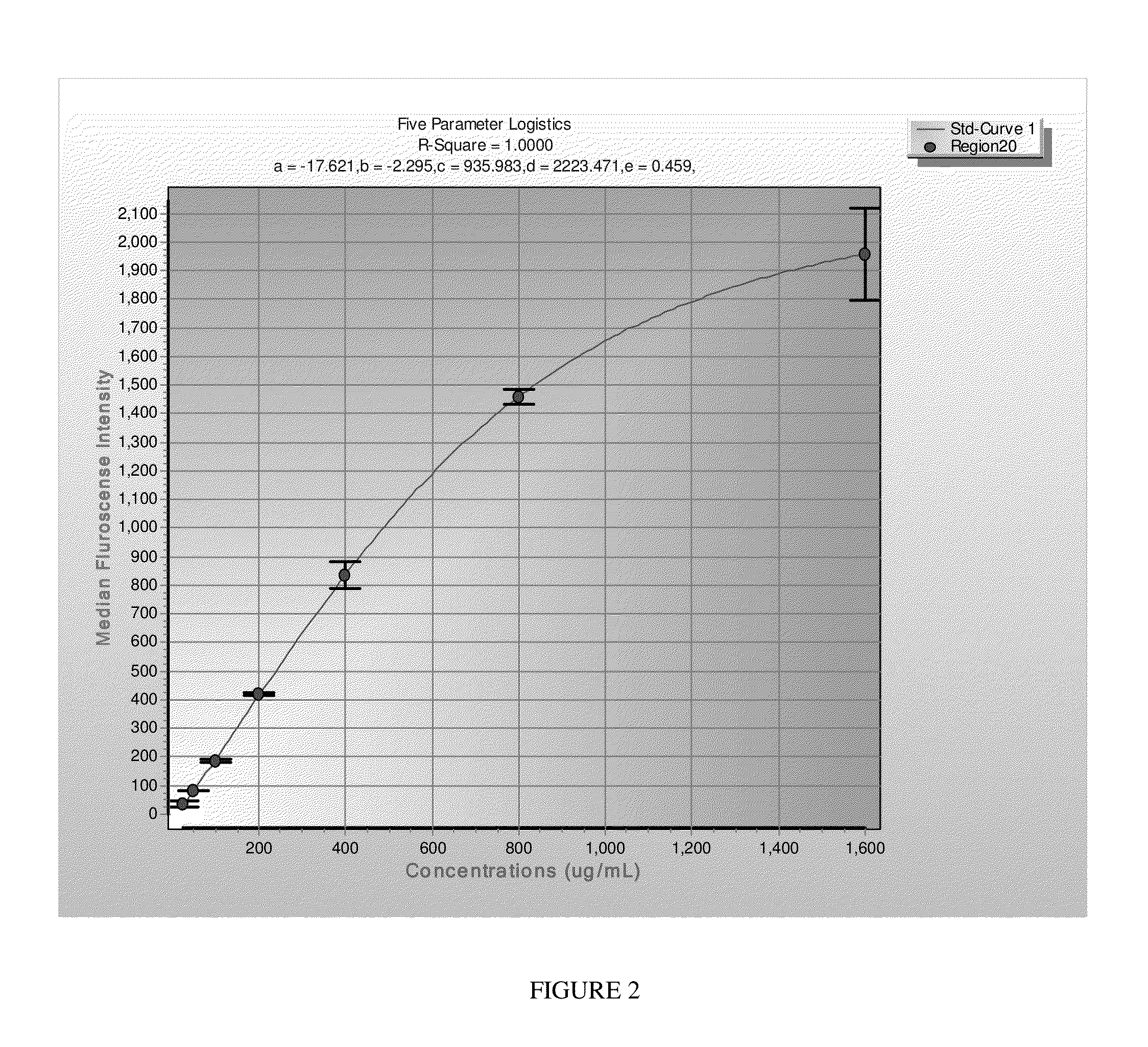System and Method for Quantifying Fragile X Mental Retardiation 1 Protein in Tissue and Blood Samples
a protein and tissue technology, applied in the field of fragile x mental retardation 1 protein detection, can solve the problems of affecting the development of an immunoassay for direct quantification and affecting the detection accuracy of fragile x mental retardation 1 protein, etc., to achieve low gas-permeability and inhibit the growth of microorganisms
- Summary
- Abstract
- Description
- Claims
- Application Information
AI Technical Summary
Benefits of technology
Problems solved by technology
Method used
Image
Examples
example 1
[0049]The method for detecting and measuring FMRP according to the present invention may be used in connection with human lymphocytes as follows. First, mononuclear cells are isolated from blood using BD Vacutainer CPT (Becton Drive, Franklin Lakes, REF 362760) according to the BD protocol. Cells are lysed in M-Per (Invitrogen) buffer supplemented with 150 mM NaCl, chymostatin (1O μg / ml), antipain (10 μg / ml, and 1 / 200 dilution of Protease inhibitor cocktail set III (Calbiochem), and sonicated using a Branson Digital Sonifier 250 (Denbury, Conn.). Cell debris are removed by centrifugation at 16,000×g at 4° C. for 15 min and the protein concentration is determined (Micro BCA Assay kit; Thermo Scientific, Rockford, Ill.). Samples are diluted in assay buffer (PBS, 1% BSA, 0.05% Tween 20, 0.05% Na Azide).
[0050]Luminex-based ELISA protocols are well known to those of skill in the art, and will not be described here in detail. In brief, microspheres (about 5,000) that are coupled with the ...
example 2
[0051]The present invention may also be used in connection with lymphoblastoid cell lines as follows. First, pellets of cultured cells (1×107) are homogenized in a dounce homogenizer (20 strokes with the loose pestle) in 1 ml of ice cold buffer (10 mM HEPES H 7.4; 200 mM NaCl, 0.5% TritonX-100, 30 mM EDTA, Protease inhibitor) available from Roche. Lysates are transferred into tubes, centrifuged at 6,800×g at 4° C. Supernatant is transferred into fresh tubes, and protein concentration determined as described above. The Luminex capture ELISA is performed as described in above with respect to human lymphocytes.
example 3
[0052]The present invention may additionally be used in connection with dried blood spots (DBS). The preparation and use of DBS is well known to those of skill in the art, and will not be described here in detail. In brief, blood samples are spotted onto ID blood staining cards (Whatman, WB100014) and let dry overnight at room temperature. Cards are then wrapped in aluminum foil and stored in sealed plastic bags at room temperature. Disks (7-mm-diameter) are punched from dried blood spots and transferred into a 2-mi screw-cap tube with wide bottom. M-Per buffer (150 μl) supplemented with 150 mM NaCl, chymostatin (10 μg / ml), antipain (10 μg / ml, and 1 / 200 dilution of Protease inhibitor cocktail set III (Calbiochem) is added and tubes incubated at room temperature on a Belly Dancer at maximum speed for 3 hours. Tubes are centrifuged for 20 sec and supernatant transferred into a fresh tube. Debris is removed by a brief centrifugation step and supernatant (20 μl to 40 μl) diluted in assa...
PUM
| Property | Measurement | Unit |
|---|---|---|
| total volume | aaaaa | aaaaa |
| pH | aaaaa | aaaaa |
| pH | aaaaa | aaaaa |
Abstract
Description
Claims
Application Information
 Login to View More
Login to View More - R&D
- Intellectual Property
- Life Sciences
- Materials
- Tech Scout
- Unparalleled Data Quality
- Higher Quality Content
- 60% Fewer Hallucinations
Browse by: Latest US Patents, China's latest patents, Technical Efficacy Thesaurus, Application Domain, Technology Topic, Popular Technical Reports.
© 2025 PatSnap. All rights reserved.Legal|Privacy policy|Modern Slavery Act Transparency Statement|Sitemap|About US| Contact US: help@patsnap.com



